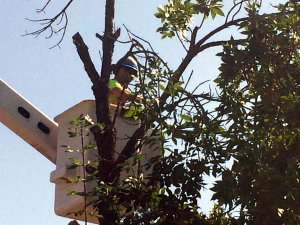City Begins Removal of Trees Infected or Threatened by Emerald Ash Borer
Treatments on More Than 1,000 Large, Healthy Ash Trees Continue.
This article is 8 years old. It was published on September 6, 2016.

ST. LOUIS
-- Beginning in the northern part of the City of St. Louis, where an Emerald Ash Borer
infestation has begun, City crews and contractors will remove weak and dying
Ash trees before they die and become dangerous. They will start their work on Wednesday,
September 7, 2016, at
The shiny green Emerald Ash Borer is responsible for destroying hundreds of thousands of Ash trees across the country and was recently discovered in the City of St. Louis. The City's Forestry Division has been preparing for the eventual onslaught of these destructive pests, which have been moving across the country from east to west for more than a decade.
The bug Agrilus planipennis, or "EAB" for short, is an invasive wood-boring pest that kills all types of Ash trees. EAB only affects Ash and Fringe tree, a related genus, and is not a threat to any other type of tree. Unfortunately, Ash is the most common tree along St. Louis streets and is also a common landscape tree.
The Forestry Division has mapped more than 15,000 public Ash trees along City streets and parks. In June, crews began treating large, healthy Ash trees before they could become infected with the bugs. Over the course of the next five years, about 14,000 Ash trees will be removed before they the EAB can kill them. A dead Ash tree is a public safety risk, as it is more likely to break and fall, especially during storms.
Ash trees slated for removal have been tagged with bright yellow flyers. Residents can see where Ash trees are located by visiting the website Show MO Trees (http://showmotrees.mytreekeeper.com/).
Forestry Commissioner Skip Kincaid, an
"Some City streets and neighborhoods will see a dramatic reduction in the number of trees along their streets," Kincaid said. "This is the reality of invasive pests and provides even more emphasis on the need to have a diverse population of trees to reduce the dramatic impacts of invasive pests.
"We are well equipped to handle EAB and have been
preparing for it since before the pest was first reported in
The City is committed to replanting the trees that are lost,
often in the same spot where Ash trees will be removed. Grant money, along with
City funds made available to aldermen each year will be used to pay for
replacement trees. The City's partner, community forestry non-profit Forest ReLeaf of Missouri, also will assist
with communicating directly with neighborhoods affected by the Ash tree
removal. Those trees will be replaced with a variety of 40 different native
The City has listed its EAB
Strategy online (www.stlouis-mo.gov/ash-borer/), including answers to
common questions and the map of
WHO: Skip Kincaid, Forestry Commissioner and Master Arborist
WHEN: Wednesday, September 7, 2016 at 10 a.m.
WHERE:
VISUALS:
- Crews removing Ash trees before EAB kill off the trees
- Emerald Ash Borer bug
- Wood sample showing EAB damage
- Neon tags to be tied around Ash trees slated for removal
-
Department:
Division of Forestry
-
Topic:
Environmental Protection
St. Louis Forestry Ash and Treated Ash Tree Interactive Map
Emeral Ash Borer in St. Louis City Information
Most Read News
- Introducing Our 2022-2023 Annual Report Explore our latest Annual Report, showcasing a year of remarkable achievements and the tangible difference we've made in our community.
- St. Louis Workforce Development Board Introduces Local Plan for Program Years 2024-2027 The SLWDB Local Plan will be available for review for 21 days from the date of this notice
- test news page this is only a test